Assets: Difference between revisions
| (3 intermediate revisions by the same user not shown) | |||
| Line 3: | Line 3: | ||
==Introduction== | ==Introduction== | ||
RangerMSP's '''Asset Management''' feature lets you easily track and manage customer equipment, PC inventory and software licenses/subscriptions. | |||
Asset management in | Asset management in RangerMSP is designed to help IT managers and service providers to quickly and efficiently get to the root of problems with the help of the Asset service [[history]] feature, and the Asset management overview of customer hardware and software inventory. | ||
Each Asset can be linked to a specific customer, and it represents their equipment (hardware) or software | Each Asset can be linked to a specific customer, and it represents their equipment (hardware) or software. | ||
For each Asset type, you can manage slightly different information which is relevant to the Asset type, and track the relevant activity. | |||
==Asset Fields== | ==Asset Fields== | ||
| Line 20: | Line 20: | ||
[[File: | [[File:assets_details_window1.png|center|link=]] | ||
| Line 61: | Line 61: | ||
== Adding New Assets == | == Adding New Assets == | ||
New Assets can be added from the Account window, Ticket window, or Asset window. You can also import Assets from Excel® files, CSV files, or other tabular formats into | New Assets can be added from the Account window, Ticket window, or Asset window. You can also import Assets from Excel® files, CSV files, or other tabular formats into RangerMSP. You can read more about importing Assets in [[Assets#Importing Assets|Importing Assets]]. | ||
It is also possible to create a Sub-Asset, which is a regular Asset that is linked to a Parent Asset. Sub Assets can be added from the Sub-Assets tab of the Parent Asset. See [[Assets#Creating New Sub Assets|Creating New Sub Assets]]. | It is also possible to create a Sub-Asset, which is a regular Asset that is linked to a Parent Asset. Sub Assets can be added from the Sub-Assets tab of the Parent Asset. See [[Assets#Creating New Sub Assets|Creating New Sub Assets]]. | ||
To add a new Asset from the application: | To add a new Asset from the application: | ||
# Click the New button in the Asset Window or Assets tab. The New Asset Window opens:<br>[[File: | # Click the New button in the Asset Window or Assets tab. The New Asset Window opens:<br>[[File:assets_new.gif|center]] | ||
#In this Window, you can set the following fields: | #In this Window, you can set the following fields: | ||
##Asset Name (mandatory) | ##Asset Name (mandatory) | ||
| Line 80: | Line 80: | ||
#For quick creation of Assets for specific Accounts, you can also add the Asset directly from the Account window. | #For quick creation of Assets for specific Accounts, you can also add the Asset directly from the Account window. | ||
#New Assets can be created from a Charge by right clicking the Charge and selecting the New Asset from Charge’ option. | #New Assets can be created from a Charge by right clicking the Charge and selecting the New Asset from Charge’ option. | ||
#New Assets can be created based on Devices managed by your RMM system, [[MSP_Integration_Setup|click here]] to learn more about | #New Assets can be created based on Devices managed by your RMM system, [[MSP_Integration_Setup|click here]] to learn more about RangerMSP’s integration with RMM systems. | ||
==Sub-Assets== | ==Sub-Assets== | ||
Sub-Assets in | Sub-Assets in RangerMSP allow you to link between assets, which sets a main parent Asset and Sub-Assets under it. This feature makes it possible to see all parts and software assets that belong to a main Asset. | ||
For example, you can create a main Asset that is a server and hold its hard-drives, antivirus licenses, and other parts as Sub-Assets. | For example, you can create a main Asset that is a server and hold its hard-drives, antivirus licenses, and other parts as Sub-Assets. | ||
| Line 141: | Line 141: | ||
You can search for Assets by information stored in the various fields of the Asset. | You can search for Assets by information stored in the various fields of the Asset. | ||
[[File: | [[File:assets_search_toolbar.png|center]] | ||
The most common searches for Assets are based on Asset Name, Asset Code, Asset Description or the Asset's Serial Numbers. To find an Asset based on information stored in one of these fields, click on the drop-down menu next to Find to select the field where the requested information is stored: | The most common searches for Assets are based on Asset Name, Asset Code, Asset Description or the Asset's Serial Numbers. To find an Asset based on information stored in one of these fields, click on the drop-down menu next to Find to select the field where the requested information is stored: | ||
[[File: | [[File:asset_search_fields.png|center]] | ||
== Tracking an Asset's Service History == | == Tracking an Asset's Service History == | ||
| Line 152: | Line 152: | ||
You can view an Asset's entire Service History in the Asset window under the Preview or History tab, together with any other activities performed for the Asset. Tickets can also be viewed in the dedicated Tickets tab. | You can view an Asset's entire Service History in the Asset window under the Preview or History tab, together with any other activities performed for the Asset. Tickets can also be viewed in the dedicated Tickets tab. | ||
[[File: | [[File:assets_service_tickets.png|center]] | ||
== Importing Assets == | == Importing Assets == | ||
You can import Assets from Excel® files, CSV files, or other table formats into | You can import Assets from Excel® files, CSV files, or other table formats into RangerMSP. When importing an Assets file, you should select the Asset type (Hardware, Software or Other), and optionally link all the imported Assets to a specific Account. If no Account is selected, the newly created Assets will not be linked to any Account, and you will be able to link them at a later stage. | ||
To import Assets, on the Main menu select '''Tools > Import and Export > Import Assets:''' | To import Assets, on the Main menu select '''Tools > Import and Export > Import Assets:''' | ||
| Line 161: | Line 161: | ||
#Select the type of Assets you want to import:''' Hardware, Software, or Other.''' | #Select the type of Assets you want to import:''' Hardware, Software, or Other.''' | ||
#Select whether to link all imported Assets to a selected Account or import them without assigning an Account to the newly created Assets. | #Select whether to link all imported Assets to a selected Account or import them without assigning an Account to the newly created Assets. | ||
#Map the imported data with the equivalent | #Map the imported data with the equivalent RangerMSP fields. | ||
#Make sure you have all the mandatory fields in your input file. Specifically, make sure to map the Asset name as this is a mandatory field (see [[Assets#Field List|Field List]]). | #Make sure you have all the mandatory fields in your input file. Specifically, make sure to map the Asset name as this is a mandatory field (see [[Assets#Field List|Field List]]). | ||
| Line 193: | Line 193: | ||
In addition, you can also customize the Asset to contain any additional information using the following: | In addition, you can also customize the Asset to contain any additional information using the following: | ||
# '''Predefined user-defined fields''' (see Field1, Field2, etc. in the Details tab). Each customized field can be renamed (right-click the field name and select Field Settings), and you can set a list of values that will be available for this field in the drop-down menu (select the Edit List option). You can read more about customizing | # '''Predefined user-defined fields''' (see Field1, Field2, etc. in the Details tab). Each customized field can be renamed (right-click the field name and select Field Settings), and you can set a list of values that will be available for this field in the drop-down menu (select the Edit List option). You can read more about customizing RangerMSP in the Setup Guide, under the [[Customization]] section. | ||
# '''Add new user-defined fields'''. You can add new tabs and fields to reflect the information you want to keep for each Asset. See [[Customization]]. | # '''Add new user-defined fields'''. You can add new tabs and fields to reflect the information you want to keep for each Asset. See [[Customization]]. | ||
# '''Asset Configuration Note'''. An easy way to define a customized data entry for an Asset. See [[Assets#Asset_Configuration_Note|Asset Configuration Note]] below. | # '''Asset Configuration Note'''. An easy way to define a customized data entry for an Asset. See [[Assets#Asset_Configuration_Note|Asset Configuration Note]] below. | ||
| Line 207: | Line 207: | ||
== Web Access == | == Web Access == | ||
In addition to managing Assets using the | In addition to managing Assets using the RangerMSP client software, the RangerMSP Web Interface allows technicians to access all Asset details from anywhere using a web browser. Technicians at customer sites can easily view Asset details together with all the previous activity and service Tickets related to a selected Asset. They can also add new Assets, update Asset details or add new Tickets for existing Assets. | ||
In addition, customers with web access can optionally have access to their Assets online. (Note that you can select not to show Assets to customers.) | In addition, customers with web access can optionally have access to their Assets online. (Note that you can select not to show Assets to customers.) | ||
[[File: | [[File:web_assets_list.png|center]] | ||
For each Asset, you can view the full Asset details, and edit it to modify Asset details. | For each Asset, you can view the full Asset details, and edit it to modify Asset details. | ||
[[File: | [[File:web_assets_details.png|center]] | ||
You can also open new Tickets for an Asset while on-site, directly from the Asset details window: | You can also open new Tickets for an Asset while on-site, directly from the Asset details window: | ||
[[File: | [[File:web_assets_details_create_new.png|center]] | ||
== Labels == | == Labels == | ||
Latest revision as of 13:48, 18 November 2024
_
_
Introduction
RangerMSP's Asset Management feature lets you easily track and manage customer equipment, PC inventory and software licenses/subscriptions.
Asset management in RangerMSP is designed to help IT managers and service providers to quickly and efficiently get to the root of problems with the help of the Asset service history feature, and the Asset management overview of customer hardware and software inventory.
Each Asset can be linked to a specific customer, and it represents their equipment (hardware) or software.
For each Asset type, you can manage slightly different information which is relevant to the Asset type, and track the relevant activity.
Asset Fields
Hardware Assets can be used to track Servers, Desktops, Laptops, Printers, Routers, Etc. For every Hardware Asset item you can manage details which are specific to that Asset, such as Code and Serial Numbers, Warranty expiration date, Vendor and Manufacturer information, license keys and codes, and more.
Software Assets can be used to track Customer Software Assets such as: Windows® Server and Desktop Licenses, Anti-Virus software licenses and subscription information, Microsoft® Office® licenses, Accounting package licenses (i.e. QuickBooks), etc.
See the Asset details window below:
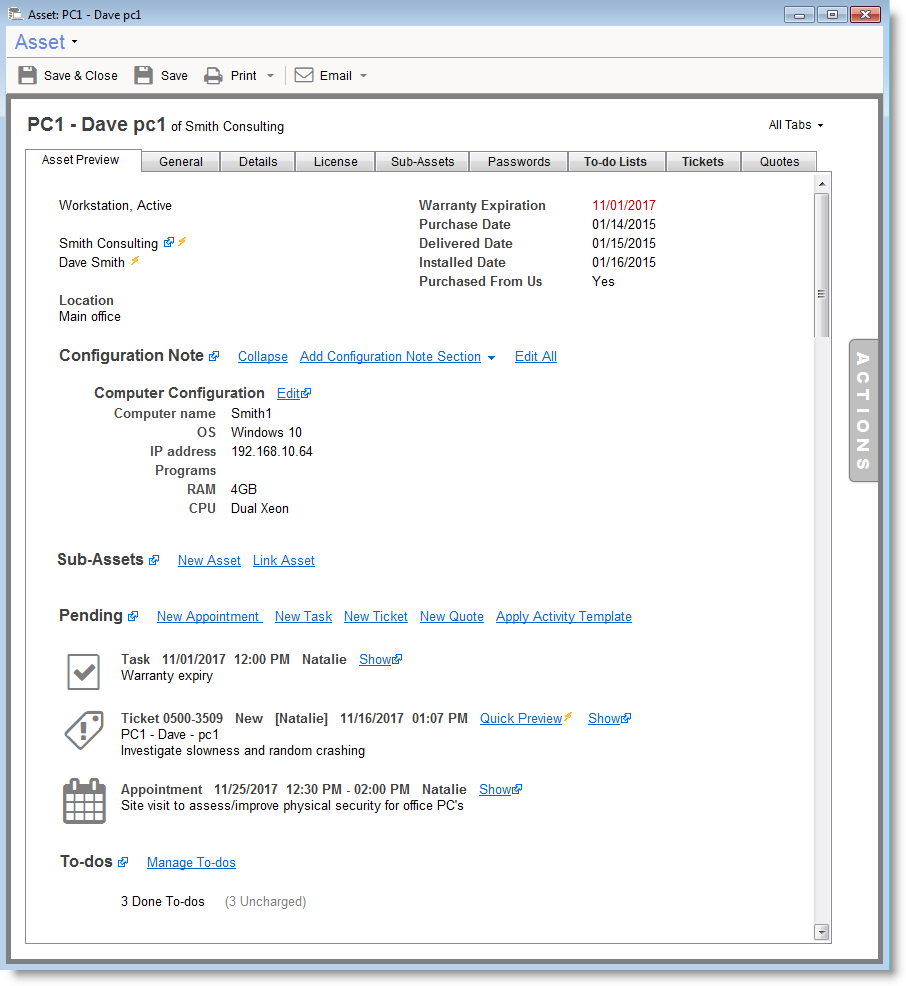
Asset Details Window
The following are the fields that are available for every Asset :
Field List
| Field | Description |
|---|---|
| Asset Name
(mandatory) |
Every Asset is given its own name so you will be able to easily identify it when viewing the Assets list. For example, when you wish to link an Asset to a new Ticket, you can click the Asset selection list, and only Assets which are relevant to that customer will be displayed. Using the Asset Name you can easily find the Asset in the list. Note that you can have multiple Assets with the same name. |
| Asset Code | The Asset code field is optional. If you choose to use it, it must have a unique identifier that is not used for any other Asset. For example, you may have several Assets with the same name (e.g. "HP Workstation Z50"), but each Asset should have its own unique identifier (e.g. "HP-Z50-001", "HP-Z50-002", etc.). Note that you can also use the Asset code for scanning-in barcodes (see Barcodes and Assets). |
| Serial No. | This field is located in the Asset's Details tab. Use this field to store serial numbers. You can also use the barcode scanner to scan a barcode number into the Serial Number fields (see Barcodes and Assets). |
| Warranty / License expiration dates | You can set the expiration dates for Warranties (for Hardware) or Licenses (for Software) in the "Wrnty./Lic. Exp." field and use it to track expiration dates. When the due date is reached, this date turns red to indicate that this Asset's warranty or license is overdue. You can also filter results by expiration date to see which Assets are about to expire so that you can notify users of warranties or licenses which should be renewed. For more details see Asset Warranties. |
| Purchase information | For each Asset you can store purchase information, such as purchase date, delivery date, price, PO, and Invoice #. |
| Purchased From Us | You can also store whether the Asset was purchased from you using the Purchased From Us flag in the Details tab. Note that when converting a won Sales Opportunity into an Asset, this flag will be automatically be set to true. |
| Vendor and Manufacturer information (tab) | Use this section to store Vendor and Manufacturer information and terms, such as the vendor serial number, manufacturer serial number, vendor PO and Invoice #, vendor warranty expiration and more. |
| License Keys and Codes (tab) | Store licenses and keys in this section to easily access equipment. You can also store special notes and instructions, such as "Need to login as admin in order to modify..." |
Adding New Assets
New Assets can be added from the Account window, Ticket window, or Asset window. You can also import Assets from Excel® files, CSV files, or other tabular formats into RangerMSP. You can read more about importing Assets in Importing Assets.
It is also possible to create a Sub-Asset, which is a regular Asset that is linked to a Parent Asset. Sub Assets can be added from the Sub-Assets tab of the Parent Asset. See Creating New Sub Assets.
To add a new Asset from the application:
- Click the New button in the Asset Window or Assets tab. The New Asset Window opens:

- In this Window, you can set the following fields:
- Asset Name (mandatory)
- Asset Code
- Quantity
- Type
- Location
- Description.
- You can also link the Asset to the Account who is the customer that owns the Asset.
- In this Window you can add Asset Configurations:

Notes:
- For quick creation of Assets for specific Accounts, you can also add the Asset directly from the Account window.
- New Assets can be created from a Charge by right clicking the Charge and selecting the New Asset from Charge’ option.
- New Assets can be created based on Devices managed by your RMM system, click here to learn more about RangerMSP’s integration with RMM systems.
Sub-Assets
Sub-Assets in RangerMSP allow you to link between assets, which sets a main parent Asset and Sub-Assets under it. This feature makes it possible to see all parts and software assets that belong to a main Asset.
For example, you can create a main Asset that is a server and hold its hard-drives, antivirus licenses, and other parts as Sub-Assets.
Sub-Assets are regular Assets, with the same fields and data like a main Asset. In addition, they have a “Parent Asset” tab that holds the link to the main Asset.
Sub Assets Features:
- Each Sub-Asset can be linked to only one Parent Asset.
- Each Parent Asset can hold unlimited number of linked Sub-Assets.
- Sub-Assets may inherit the Account from its Parent Asset.
- It is possible to remove the link between Sub Assets and their parents when needed.
Creating New Sub Assets
Sub-Assets are regular Assets, that are linked to a Parent Asset.
Each Asset has a ‘Sub-Assets’ tab, from which you can create new Sub-Assets or link to existing Assets. Any Asset can be a Parent Asset as long as it is not being a Sub-Asset.
An Asset that has been linked as a Sub-Asset, holds a ‘Parent Asset’ tab, that shows the linked Parent Asset. From this tab you can also unlink the Assets.
Once a new Asset is created, it is automatically assumed to be a Parent Asset, that may hold Sub-Assets and therefore the Sub-Assets tab is displayed. From this tab you can create new Sub Assets or link to existing ones.
To create a Sub-Asset:
- Open the details Window of the Asset you services as the Parent Asset.
- Go to Sub-Assets tab:
- Click New to create a new Asset that will be the Sub Asset.
- Enter the details of the Asset.
- Note that the Account is automatically taken from the Parent Asset. The Account cannot be changed because both Assets must belong to the same Account in order to be linked.
- Or, click Link Asset to link an existing Asset as a Sub-Asset
- An Asset selection Window opens.
- Select the Asset from the list.
Unlinking Sub Assets
Unlinking a Sub-Asset from its Parent can be done from:
- From the Sub-Asset Window:
- Go to the Parent Asset tab.
- Click Unlink.
- From the Parent Asset Window:
- Go to Sub-Assets tab.
- Right-click the Sub-Asset you want to unlink and choose Unlink.
- Or, select the Sub-Asset you want to unlink and click the Unlink button at the bottom part of the tab.
Parent Assets
All new Assets are automatically assumed to be Parent Assets, however, they are not linked to any Sub Assets. Adding Sub-Assets is optional.
You can add Sub-Assets from the Sub-Assets tab, or from the Sub-Assets area in the Preview Window. Once adding Sub-Assets, the Asset becomes a Parent Asset. Note that only assets belonging to the same Account can be linked together.
Linking Assets to Tickets
Each Asset can be linked to an Account as well as to a specific Ticket. Linking an Asset to a Ticket helps you track the Asset's service history (see Tracking an Asset's).
When creating a new Ticket, you can select the relevant Asset which should be linked to this Ticket by clicking the drop-down menu and selecting the relevant Asset. If you want to add a new Asset to the Ticket, you can do so from within the New Ticket window by clicking the "+" button and adding the new Asset on-the-fly. This new Asset will be automatically linked to the Ticket and to the Account.
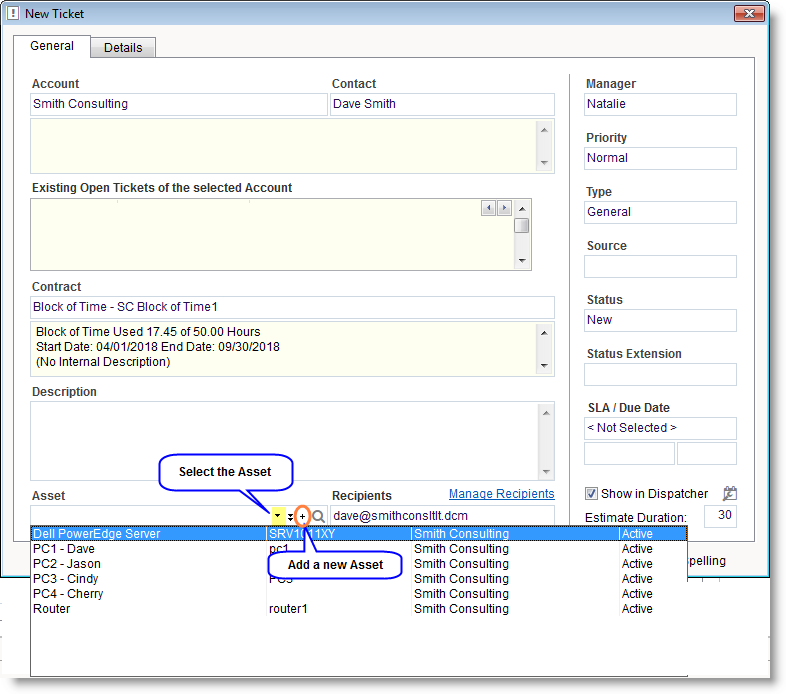
Searching for Assets
You can search for Assets by information stored in the various fields of the Asset.

The most common searches for Assets are based on Asset Name, Asset Code, Asset Description or the Asset's Serial Numbers. To find an Asset based on information stored in one of these fields, click on the drop-down menu next to Find to select the field where the requested information is stored:
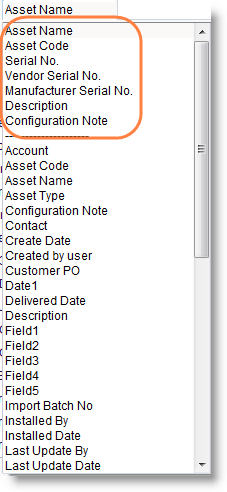
Tracking an Asset's Service History
When an Asset is reported to have a problem, you can open a Ticket and Link it to the Asset so you will have a history record of all service Tickets opened for this Asset. This helps you track recurring problems for the Asset, etc. Before fixing an Asset, you can easily view the Asset's service history to help you decide how to handle the problem.
You can view an Asset's entire Service History in the Asset window under the Preview or History tab, together with any other activities performed for the Asset. Tickets can also be viewed in the dedicated Tickets tab.
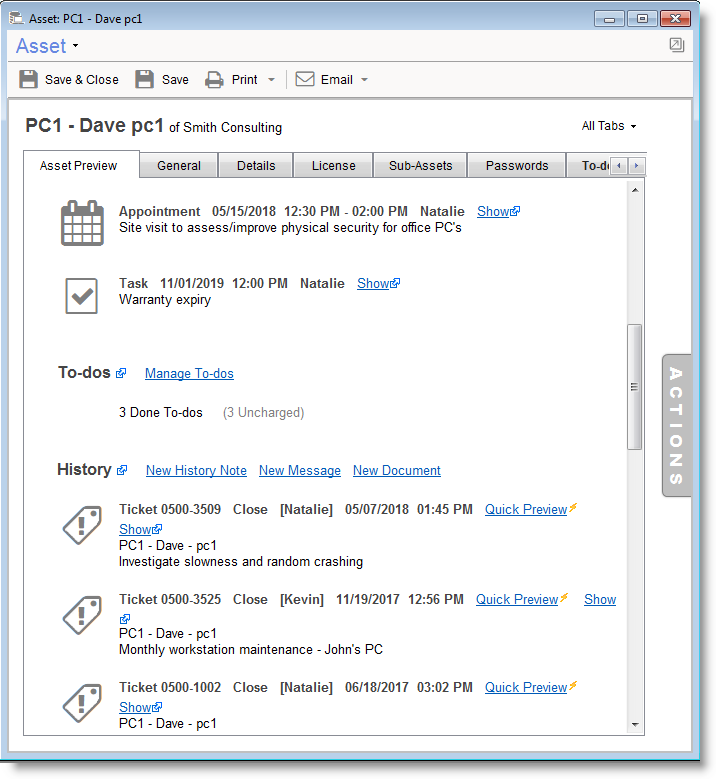
Importing Assets
You can import Assets from Excel® files, CSV files, or other table formats into RangerMSP. When importing an Assets file, you should select the Asset type (Hardware, Software or Other), and optionally link all the imported Assets to a specific Account. If no Account is selected, the newly created Assets will not be linked to any Account, and you will be able to link them at a later stage.
To import Assets, on the Main menu select Tools > Import and Export > Import Assets:
- Select the file format.
- Select the type of Assets you want to import: Hardware, Software, or Other.
- Select whether to link all imported Assets to a selected Account or import them without assigning an Account to the newly created Assets.
- Map the imported data with the equivalent RangerMSP fields.
- Make sure you have all the mandatory fields in your input file. Specifically, make sure to map the Asset name as this is a mandatory field (see Field List).
You can also import Assets from the Assets tab in the Accounts window by right-clicking and selecting Import Assets... In this case all the imported Assets will be linked to the current Account).
Transferring Assets between customers
To transfer an Asset to another Account:
- Open the Asset window.
- Go to General tab.
- Choose the Account.
Notes:
- Once an Asset is linked to an Account, and service Tickets are opened for it, it cannot be transferred to another Account.
- Parent Assets that have Sub-Assets with service Tickets cannot be transferred to a different Account as well, because Sub-Assets must be linked to the same Account (see Transferring a Parent Assets).
- If you wish to transfer the Asset (the equipment or software license) to a different customer/Account, you should copy the Asset (right-click the Asset and select Copy...), and select the new customer for the Asset.
You can keep a link to the old Asset in the newly created Asset so you will be able to track its history later on. This can be done by adding a note which indicates that this is a new Asset, and that lists the old Asset's name/code.
Transferring a Parent Asset to a Different Account
When changing the Account of a Parent Asset (i.e. an Asset holding Sub-Assets), this affects also its Sub-Assets, and updates their Account as well.
To transfer a Parent Asset to a different Account:
- Open the Parent Asset Window.
- Go to General Tab.
- Choose the new Account. The following Window opens:
- Click OK to apply the change.
Customizing Assets
Each Asset includes many fields which help you store information for tracking the current status of equipment, as well as an Asset's service history so you can have a complete overview of an Asset's history next time you need to handle it.
In addition, you can also customize the Asset to contain any additional information using the following:
- Predefined user-defined fields (see Field1, Field2, etc. in the Details tab). Each customized field can be renamed (right-click the field name and select Field Settings), and you can set a list of values that will be available for this field in the drop-down menu (select the Edit List option). You can read more about customizing RangerMSP in the Setup Guide, under the Customization section.
- Add new user-defined fields. You can add new tabs and fields to reflect the information you want to keep for each Asset. See Customization.
- Asset Configuration Note. An easy way to define a customized data entry for an Asset. See Asset Configuration Note below.
Asset Configuration Note
The Asset Configuration Note provides an easy way to define a customized data entry for an Asset. The Configuration Note is a structured field, which provides an easy way to enter data which is displayed as separate fields and gives a convenient view of the details.
The purpose of the Configuration Note is to keep Asset configuration details, depending on the Asset type. You can define various templates which hold different data according to the Asset type, and use the templates to conveniently enter the configuration details.
Each Asset can hold multiple notes, allowing you to enter various types of data for the Asset.
See more details and usage instructions in Asset Configuration Note.
Web Access
In addition to managing Assets using the RangerMSP client software, the RangerMSP Web Interface allows technicians to access all Asset details from anywhere using a web browser. Technicians at customer sites can easily view Asset details together with all the previous activity and service Tickets related to a selected Asset. They can also add new Assets, update Asset details or add new Tickets for existing Assets.
In addition, customers with web access can optionally have access to their Assets online. (Note that you can select not to show Assets to customers.)
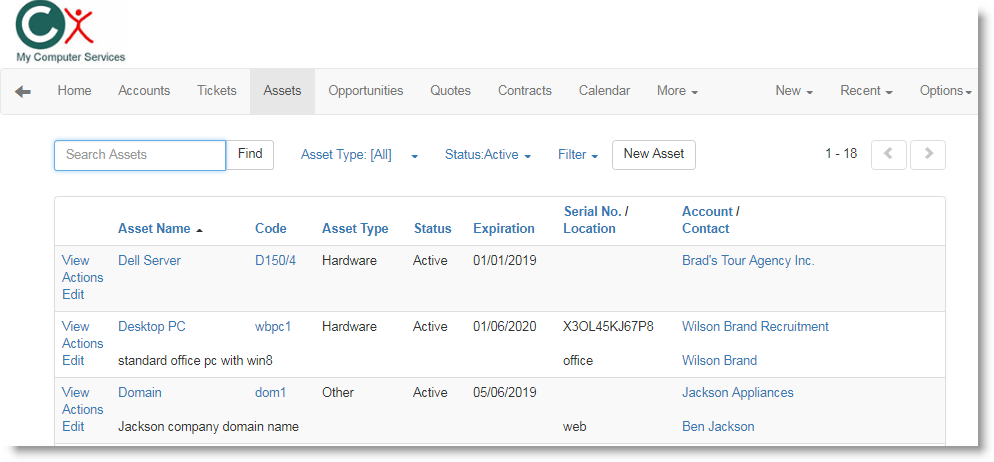
For each Asset, you can view the full Asset details, and edit it to modify Asset details.
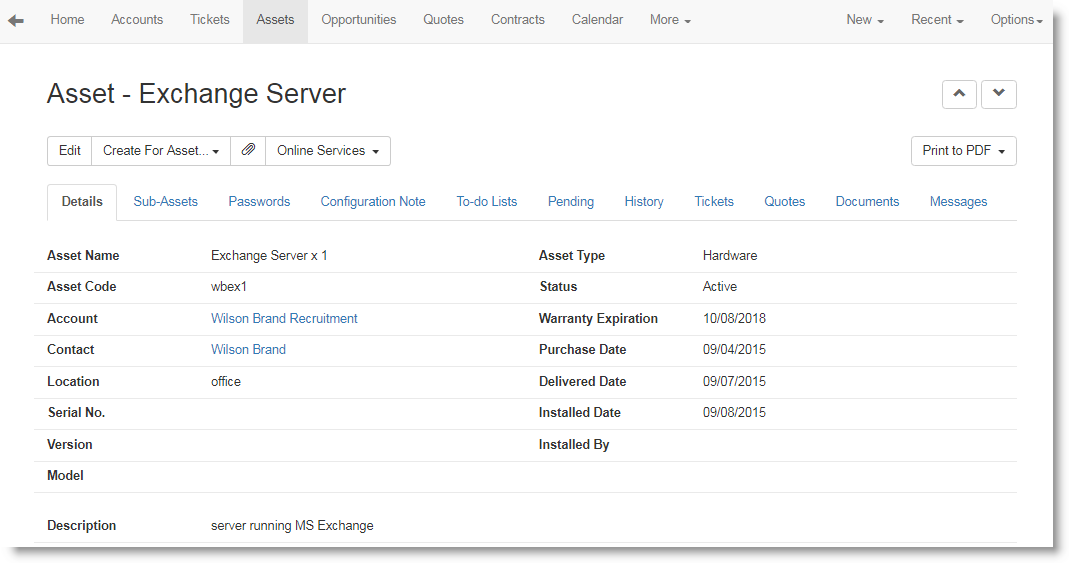
You can also open new Tickets for an Asset while on-site, directly from the Asset details window:
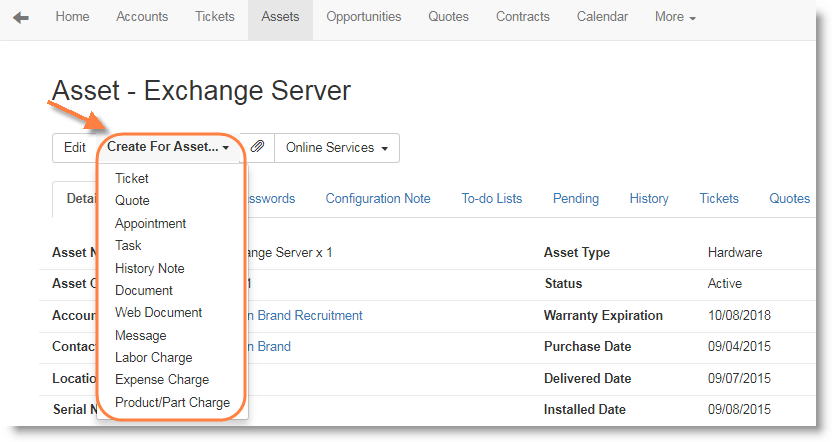
Labels
Assets can have default Labels defined so that all Tickets created under a specific Asset will have the default labels applied automatically. See full details on default Labels here.